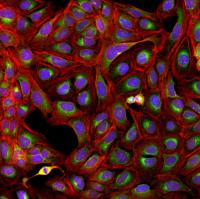 The process of drug discovery is long and complex, often taking years and costing billions of dollars to bring a single drug to market. Traditionally, drug discovery has relied on in vitro assays, which are experiments conducted outside of a living organism, to identify potential drug candidates. However, recent advances in high-content screening have made it possible to get a better understanding of how drugs impact cellular pathways, accelerating the drug discovery process.
The process of drug discovery is long and complex, often taking years and costing billions of dollars to bring a single drug to market. Traditionally, drug discovery has relied on in vitro assays, which are experiments conducted outside of a living organism, to identify potential drug candidates. However, recent advances in high-content screening have made it possible to get a better understanding of how drugs impact cellular pathways, accelerating the drug discovery process.
High-content screening is a type of drug discovery method that utilizes high-throughput imaging and analysis to assess multiple endpoints simultaneously at a cellular resolution. This approach allows for the interrogation and quantitation of cellular response of disease models to treatments, stimuli, or alterations in protein expression. High-content screening differs from traditional drug discovery methods in that it provides richer datasets than traditional assays, allowing for the examination of the specific effect of compound treatments on specific sub-populations of cells, as well as providing access to more complex measurements than can be accomplished with traditional assay formats.
Visikol Inc. is a contract research services company that specializes in advanced tissue imaging and advanced cell culture services to accelerate the drug discovery and development process. Visikol provides end-to-end services that include 3D tissue imaging, multiplex tissue imaging, digital pathology, 2D cell culture assays and 3D cell culture assays. Visikol’s expertise lies in transforming tissues into actionable insights and bridging the gap between in vitro assays and in vivo results through the use of best-in-class cell culture models.
Cell Painting Assay
One of the services offered by Visikol that can revolutionize the drug discovery process is the Cell Painting Assay. Cell Painting is a high-content, multiplexed image-based assay used for cytological profiling. The technique involves staining several compartments of the cell with organelle-specific stains to visualize phenotypic examination of physiological, metabolic, or epigenetic perturbations. The resulting data can be analyzed using hundreds to thousands of parameters, allowing for the development of mechanical explanations for how a drug is operating and affecting samples.
Visikol scientists used the cell painting technique to elucidate the effects of a small molecule anti-proliferative therapeutic and cytochalasin B in cancer cells. The resulting images showed the effects of the drugs on the ER network, cytoskeleton, and mitochondria. This approach aids pharmaceutical research in solving drug discovery problems with high specificity and sensitivity with high temporal and spatial resolutions.
The Cell Painting Assay is a powerful tool for drug discovery, as it allows researchers to visualize changes at the cellular level and analyze hundreds of parameters. This wealth of information can help researchers make informed decisions about which compounds to pursue, accelerating the drug discovery process. Visikol’s future perspectives include incorporating high-throughput robotics and automation to seed cells and deliver compounds to microplates, improving high throughput technology in imaging and its computational image processing pipeline by integrating the data generated with AI and machine learning tools.
High-content screening is a powerful tool for drug discovery, and Visikol’s Cell Painting Assay is a game-changer in this field. By providing researchers with a wealth of information about how drugs impact cellular pathways, the Cell Painting Assay can help researchers make informed decisions about which compounds to pursue. Reach out to a member of our team if you’re interested in learning more.
